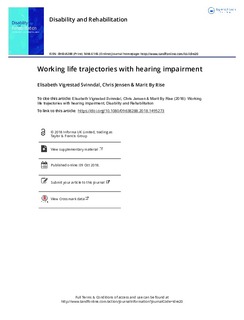| dc.contributor.author | Elisabeth Vigrestad, Svinndal | |
| dc.contributor.author | Jensen, Chris | |
| dc.contributor.author | Rise, Marit By | |
| dc.date.accessioned | 2018-10-11T08:19:29Z | |
| dc.date.available | 2018-10-11T08:19:29Z | |
| dc.date.created | 2018-10-09T14:31:44Z | |
| dc.date.issued | 2018 | |
| dc.identifier.issn | 0963-8288 | |
| dc.identifier.uri | http://hdl.handle.net/11250/2567552 | |
| dc.description.abstract | Purpose: The aim was to identify and explore factors, which facilitate or hinder work participation for people with hearing impairment.
Materials and methods: In-depth interviews with 21 hearing impaired individuals of 32–67 years of age with a present or recent vocational affiliation were conducted. The analysis was conducted using a grounded theory approach.
Results: The analysis resulted in a conceptual framework of working life trajectories evolving through three phases of acknowledgement of hearing loss impact: the pre-acknowledgement, acknowledgement, and post-acknowledgement phase. The phases were influenced by the qualities of three contexts: the personal, the workplace, and the service provider. The qualities of the contexts, together with the amount of time spent in a pre-acknowledgement phase, formed the trajectories towards continuation of work participation or towards a disconnection. Accumulated risk factors constituted increased likelihood of disconnecting trajectories, while accumulated facilitating factors supported sustainable trajectories.
Conclusions: The results revealed a need for extended support at the workplaces, which includes the manager, colleagues, and professionals in the aim of preventing exhaustion and facilitate work participation among employees with hearing impairments. Joint action in facilitating communicative participation would share the responsibility for accommodation measures and broaden the room for manoeuver at the workplace.
Implications for rehabilitation
Fatigue prevention in employees with hearing loss needs to be addressed in occupational rehabilitation.
Knowledge transfer on hearing loss implications needs to be included in aural rehabilitation.
Occupational rehabilitation professionals and professionals targeting hearing impairments should enter into systematic, multidisciplinary follow-up at the worksite. | nb_NO |
| dc.language.iso | eng | nb_NO |
| dc.publisher | Taylor & Francis | nb_NO |
| dc.rights | Attribution-NonCommercial-NoDerivatives 4.0 Internasjonal | * |
| dc.rights.uri | http://creativecommons.org/licenses/by-nc-nd/4.0/deed.no | * |
| dc.title | Working life trajectories with hearing impairment | nb_NO |
| dc.title.alternative | Working life trajectories with hearing impairment | nb_NO |
| dc.type | Journal article | nb_NO |
| dc.type | Peer reviewed | nb_NO |
| dc.description.version | publishedVersion | nb_NO |
| dc.source.journal | Disability and Rehabilitation | nb_NO |
| dc.identifier.doi | 10.1080/09638288.2018.1495273 | |
| dc.identifier.cristin | 1619063 | |
| dc.description.localcode | (C) 2018 Informa UK Limited, trading as Taylor & Francis Group. This is an Open Access article distributed under the terms of the Creative Commons Attribution-NonCommercial-NoDerivatives License (http://creativecommons.org/licenses/by-nc-nd/4.0/), which permits non-commercial re-use, distribution, and reproduction in any medium, provided the original work is properly cited, and is not altered, transformed, or built upon in any way. | nb_NO |
| cristin.unitcode | 194,65,20,0 | |
| cristin.unitcode | 194,65,35,0 | |
| cristin.unitname | Institutt for samfunnsmedisin og sykepleie | |
| cristin.unitname | Institutt for psykisk helse | |
| cristin.ispublished | true | |
| cristin.fulltext | original | |
| cristin.qualitycode | 1 | |

